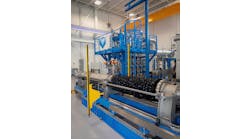VALVES, sensors, actuators, etc. are comfortable tools of our trade. Today. However, while these will continue to be significant elements of control and automation solutions, several intertwining areas of explosive growth are poised to offer almost unimaginable changes and improvements that will open up vast but tiny new control opportunities and tools. Swimming in these new seas will require very different engineering knowledge, techniques, and piece-parts.
The word that probably springs to mind is "nanotechnology," broadly defined as working with things sized below 100 nanometers (100 billionths of a meter.) And that's true - new building blocks, such as carbon nanotubes, offer incredible opportunities for tiny electronics (such as carbon nanotube transistors), new materials, and new venues for process control (as in a complex fluidic process implemented on a single tiny chip).
But the real changes and opportunities that lie ahead, only partially based on nanotechnology, are those that will blend four previously disparate fields in ways that fuel synergistic advances so quiuckly, and so broadly, that we'll wonder why we ever thought that Moore's Law of the past 35 years was considered "fast."
This blending will involve the coming together of nanotechnology, biology and medicine, information sciences, and cognitive sciences (NBIC), and will certainly give traditional automation and control devices new performance and capabilities. But very new capabilities and challenges will appear as the boundaries blur between things living and dead, and things mechanical and biological and electronic.
We have to keep up, or we'll find ourselves feeling like "relay logic" engineers who refused to educate themselves as transistors and chips and PLCs silenced the quiet clicking. Yet NBIC inroads are so new that there's not yet any roadmap in place to define a self-education path. Nevertheless, we can begin to get an overview of today's laboratory and prototype NBIC efforts to help us understand the breadth, and the differences, in tomorrow's environments and tools and "machines." For examples:
Superman's Muscles
The comic book hero is well known for his ultra strong muscles, but similar artificial "muscles" might be just as useful to replace traditional electric motors in many applications. These are hydrogen-powered artificial muscles, one-hundred times stronger than normal muscles, and able to do one-hundred times the work while burning hydrogen and alcohol! They may one day power prosthetic limbs, autonomous robots, and control devices large and tiny.
Carbon nanotubes are at the heart of this invention in several ways: in a fuel cell type reaction to generate energy; as supercapacitors to store the energy; and, using quantum mechanical and electrostatic effects, to induce a "dimensional change" -- the muscle-like contractions that do the work. Such building blocks will enable machines that weren't previously practical such as wings that continuously morph to optimize flight, replacement human muscles that derive their energy from the same "fuel" used by natural muscles, and far more.
Using Nemo
Disney entertained us with a film about fish swimming in the ocean, but we're moving towards the day of tiny autonomous robots that swim through pipes and through blood vessels. Many motive designs are being explored, such as molecular rotating propellers, whipping flagella like some bacteria, and even unique, fast-moving "PushMePullYou" microswimmers..
What could these be good for? Perhaps to deposit repair materials to a production surface without shutting down its process. Or carry a solvent to dissolve a "clot" in human or fluidic systems. As we become familiar with the "technology," we'll envision new approaches to old problems, and solutions to new problems we haven't yet dreamed of.
Squeezable & Strong
Imagine a chemically and heat resistant foam that can be compressed 85% many thousands of times yet springs back perfectly when released. This new material is made from tough and strong carbon nanotube molecules that have characteristics so astounding that heads have to shake in wonder. And this is just one example of how nanotechnology is changing material characteristics at the nano and macro scales (Nature, Nov. 24, 2005).
More Power for Less
Most control devices, whether they’re sensors or actuators, require power to do ther jobs. Yet in outdoor and remote areas, power can be difficult and expensive to provide. Today, some of these needs are met by solar cell arrays, but they’re notoriously expensive and inefficient, converting at best 15-20% of light into current. So, what if you could buy solar cells appraching 40-50% efficiency? Though this doublng of performance may seem unlikely, using carbon nanotubes is already leading us in this direction.
One company, AMBIT, already has found a way to add about 1 billion nanotubes to traditional silicon solar cells. These tubes act as “optical antennas” to recover more ambient light energy partially by extending the light spectrum from which they can convert energy. This technology is called “nanotube-on-silicon,” and it’s already demonstrated an 18% efficiency improvement over traditional solar cells. This may be the beginning of a revolution in solar cell efficiency. In fact, DARPA is fundng a $54 million research project, which may use “engineered biomolecules to guide the assembly of inorganic materials” to produce cost-effective solar cell prototypes that deliver 50% efficiency by 2009. Such efficient remote power might enable sensing and control in areas that were too expensive before, and enable a decentralized energy grid as buildings become more energy self-sufficient.
All possible due to the melding of NBIC technologies, these ideas represent the tip of the iceberg of changes that are already beginning to radically alter the ways we engineer products and control processes. These changes are taking place so fast, and now the rate of change itself is accelerating because of the synergy of NBIC. So, when examining our careers it’s not safe to think, “I’ll just let the next generation of engineers train for this.” Continuing education is the key to keeping “relay logic” syndrome at bay. Don’t blink!
| About the Author |




